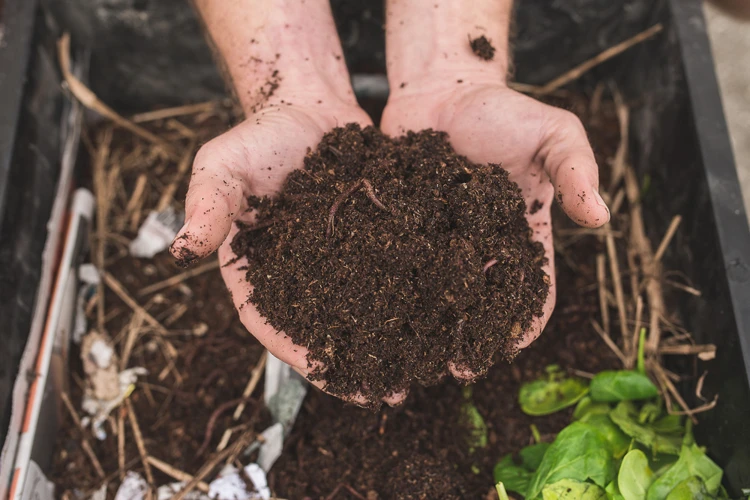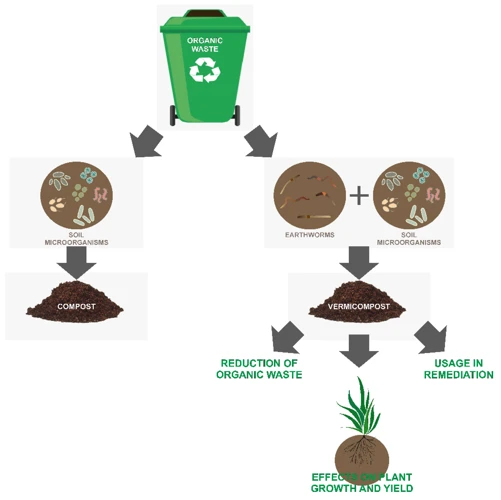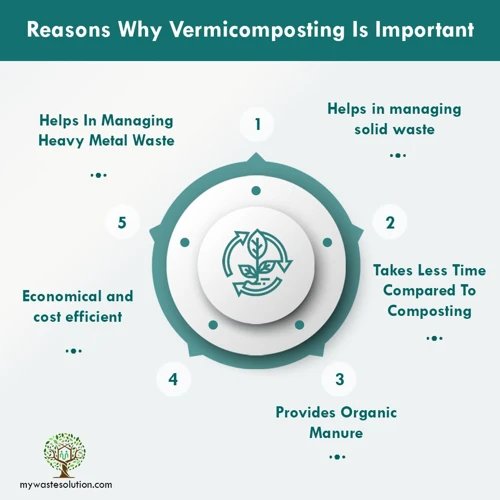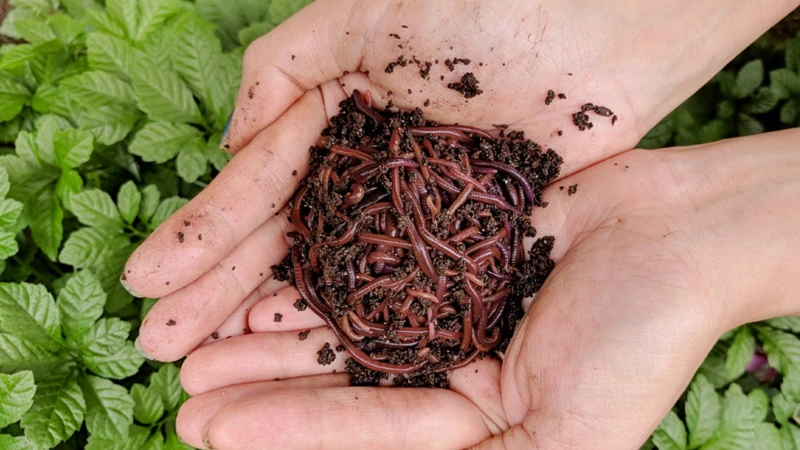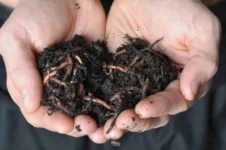
Vermicomposting and Cannabis: A Perfect Match
Introduction
Contents
Embarking on a cannabis cultivation journey can be exciting and daunting at the same time. There are several factors to consider, but one of the key elements that can help ensure a successful harvest is the quality of the soil. Growing healthy cannabis plants requires nutrient-rich soil, which can be achieved through vermicomposting. This natural process involves utilizing worms to break down organic matter, creating a potent fertilizer. In this guide, we will explore the role of vermicomposting in a successful cannabis garden and provide step-by-step instructions on how to build and maintain a vermicomposting system.
What is vermicomposting?
Vermicomposting is a type of composting that utilizes worms to break down organic material into nutrient-rich compost. The process involves feeding organic waste such as kitchen scraps and yard debris to worms, who then digest and transform the waste into a high-quality fertilizer. Vermicomposting is a simple and efficient way to create a natural fertilizer for your cannabis plants.
The benefits of vermicomposting for cannabis cultivation include:
| Nutrient-rich soil: | Vermicompost is rich in nutrients such as nitrogen, phosphorus, and potassium, which are essential for cannabis growth and development. These nutrients are more readily available to plants when they are in vermicompost form. |
| Bacterial and fungal support: | Vermicompost contains beneficial microorganisms like bacteria and fungi, which help to break down nutrients and make them more available to plant roots. These microorganisms also help to suppress harmful pathogens in the soil. |
| Pest control: | The microorganisms in vermicompost help to deter harmful pests like nematodes and mites, reducing the need for chemical pesticides. |
By utilizing vermicomposting in your cannabis garden, you can improve soil fertility and reduce the need for synthetic fertilizers and pesticides. To learn more about the benefits of composting for cannabis plants, check out our article on benefits of composting for cannabis plants.
Why is vermicomposting useful for cannabis cultivation?
Vermicomposting is the process of using worms to break down organic material and turn it into nutrient-rich compost. This approach is particularly useful for cultivating cannabis because it provides a range of benefits that can enhance plant growth and yield. The following table highlights some of the key benefits of vermicomposting for cannabis cultivation:
| Benefits of Vermicomposting for Cannabis Cultivation |
|---|
| Improved soil fertility: Vermicompost contains a range of nutrients, including nitrogen, phosphorus, potassium, and magnesium. These nutrients are essential for healthy plant growth and can help boost yields. |
| Bacterial and fungal support: Vermicompost is rich in beneficial microbes, including bacteria and fungi, that can help protect plants from harmful pathogens and promote overall soil health. |
| Pest control: Certain types of worms used in vermicomposting, such as red wigglers, can help control pest populations in the soil. They consume a range of insect larvae and other pests, reducing the need for chemical pesticides. |
| Improved water retention: Vermicompost has a spongy texture that can help improve soil structure and water retention. This can be particularly useful in dry or drought-prone areas, where plants may struggle to get enough moisture. |
| Reduced environmental impact: Vermicomposting is an environmentally friendly way of recycling organic waste. By using worms to compost food scraps, yard waste, and other materials, growers can reduce their environmental impact and create a sustainable source of soil amendment. |
Vermicomposting is a valuable tool for cannabis growers who want to cultivate healthy, high-yielding plants while minimizing their environmental impact. By building a vermicomposting system and incorporating vermicompost into their soil, growers can enjoy a range of benefits that support plant growth and overall soil health.
What You Need to Get Started
Embarking on a vermicomposting project for your cannabis garden can be an exciting prospect, but it’s important to ensure that you have the right tools and equipment to get started. Before you dive in, take a moment to consider what you’ll need to set up a successful vermicomposting system. From a suitable container to the right type of worms and bedding materials, there are several key elements that you’ll need to have in place in order to create nutrient-rich soil that will support healthy cannabis growth. Let’s take a closer look at some of the essential components you’ll need to get started with vermicomposting.
The right container
When it comes to vermicomposting, having the right container is crucial for the success of your system. Here are some factors to consider when choosing the right container for your worms:
| Factor to Consider | Possible Containers |
|---|---|
| Aeration | A plastic or wooden bin with a lid that has several small holes for air flow. |
| Size | A container that is at least 8-12 inches deep, but not too large that the worms cannot break down the food scraps efficiently. |
| Drainage | A bin with a spigot or holes in the bottom to allow excess moisture to drain out. |
| Material | A plastic, wooden, or metal bin that is non-toxic and able to withstand moisture and acidity from the worm castings. |
Keep in mind that you can also choose to purchase pre-made vermicomposting bins or create your own DIY bin using materials such as plastic storage containers or wooden crates. Ultimately, the right container for your vermicomposting system largely depends on your personal preference and the specific needs of your cannabis garden.
The right worms
When it comes to vermicomposting, the type of worms you use is very important. Not all worms are created equal and not all of them are suitable for composting.
The right worms for vermicomposting:
| Worm Type | Description |
|---|---|
| Red Wigglers: | Also known as Eisenia fetida, are the most commonly used worms for composting. They are efficient eaters, can tolerate a wide range of temperatures, and reproduce quickly. |
| European Nightcrawlers: | Also known as Eisenia hortensis, are a larger species of worm than red wigglers. They are known for their ability to burrow deeper into the soil and can tolerate cooler temperatures than red wigglers. They are also great for fishing bait. |
| African Nightcrawlers: | Also known as Eudrilus eugeniae, are a tropical species of worm that are great for vermicomposting in warmer climates. They are efficient composters and can tolerate a wide range of temperatures. |
It is important to note that regular garden worms are not suitable for vermicomposting as they cannot compost at the same rate as red wigglers or other vermicomposting worms. When choosing which worms to use, it is important to consider your climate and the type of waste you will be composting. Red wigglers are a great all-purpose worm for most vermicomposting setups.
The right bedding
When it comes to vermicomposting, choosing the right bedding for your worms is crucial for their health and overall success of the system. Your bedding should create the ideal environment for the worms to thrive and ensure that they have enough space to move around and breathe. Here are some options for the best bedding for your worm bin:
| Bedding Material | Advantages | Disadvantages |
|---|---|---|
| Newspaper | Abundant and easy to find, holds moisture well | May take longer to break down, can cause matting if not shredded properly |
| Cardboard | Easy to obtain, breaks down quickly, high in carbon | May contain ink and other chemicals, should be shredded before use |
| Coco Coir | Renewable and sustainable, pH-neutral, good for moisture control | May need additional nitrogen source to balance carbon content, may be more expensive |
| Peat Moss | Good for water retention, high in carbon, easy to find | Not environmentally sustainable, may cause pH imbalance if not used in moderation |
| Straw | High in carbon, encourages air flow and helps prevent matting | Takes longer to break down, may be difficult to find in certain locations |
It’s important to avoid using materials that can harm the worms, such as glossy paper or materials with chemicals or pesticides. Additionally, make sure to shred or cut your bedding into small pieces to allow for easier digestion by the worms. As a general rule of thumb, a good ratio to follow is one part food scraps to two parts bedding. With the right bedding, your worms will be happy and your vermicomposting system will thrive.
How to Build a Vermicomposting System
Establishing a healthy vermicomposting system may seem like a daunting task, but with the right guidance, it can be done successfully. To begin, you will need to gather the necessary components and invest your time and effort into building a suitable worm bin. The process may be challenging at times, but the rewards are worth the investment, especially when it comes to optimizing the growth of your cannabis plants. In this section, we will provide a step-by-step guide for building and maintaining a productive vermicomposting system.
Step-by-step guide to building your own worm bin
Here is a step-by-step guide to building your own worm bin:
| Step 1: | Find a container that is at least 8 inches deep and has a lid. This can be a plastic storage bin or a wooden box. |
| Step 2: | Drill several small holes in the bottom of the container for drainage. |
| Step 3: | Layer the bottom of the container with shredded newspaper or dry leaves to create bedding for the worms. |
| Step 4: | Add some moistened shredded newspaper on top of the bedding to make it damp but not wet. |
| Step 5: | Introduce the worms to the bedding. You can purchase them from a composting supplier or find them in your garden. |
| Step 6: | Cover the bedding with a sheet of plastic wrap to keep it dark and moist. |
| Step 7: | Feed the worms regularly with fruit and vegetable scraps, coffee grounds, and other organic materials. Be sure not to overfeed them. |
| Step 8: | Harvest the vermicompost from the bin by scooping it out and separating it from the worms and any undecomposed material. |
Note: It’s important to maintain a proper balance of moisture and temperature in the worm bin to ensure the health and productivity of the worms. Avoid adding meat, dairy, or oily foods to the bin as they can attract pests and create unpleasant odors.
Tips for maintaining a healthy vermicomposting system
Maintaining a healthy vermicomposting system requires attention to detail and a bit of effort. Here are some tips to ensure that your system runs smoothly:
- Balance: It’s important to maintain a balance of carbon-rich (brown) and nitrogen-rich (green) materials in the bin. Too much of one or the other can lead to slow decomposition and unpleasant odors. Aim for a ratio of roughly 2:1 brown to green materials.
- Moisture: Worms need a moist environment to thrive, but too much moisture can lead to anaerobic conditions that can be harmful to them. Check the bedding regularly and add water as needed to keep it damp but not waterlogged.
- Temperature: Worms prefer temperatures between 55-77°F (13-25°C). If the bin gets too hot, they may try to escape, and if too cold, they will become sluggish and less productive. Keep the bin in a shady, sheltered spot that stays within this temperature range.
- Aeration: Worms need oxygen to survive, so it’s important to aerate the bedding occasionally. This can be as simple as stirring it with a stick or fork. Just be careful not to disturb the worms too much.
- Food: Worms can eat a wide variety of organic materials, but some things should be avoided, such as meat, dairy, and oily or salty foods. Also, avoid overfeeding the worms – start with a small amount and wait until it has been fully consumed before adding more.
- Harvesting: When it’s time to harvest the vermicompost, avoid disturbing the worms as much as possible. One way to do this is to push all of the compost to one side of the bin and add fresh bedding and food to the other side. The worms will migrate to the new bedding, leaving the compost behind for harvesting.
With these tips in mind, maintaining a healthy vermicomposting system should be relatively easy, and your worms will reward you with nutrient-rich compost that will help your cannabis plants thrive.
The Benefits of Vermicomposting for Cannabis
As a cannabis cultivator, you’re always looking for ways to improve the health and yield of your plants. The answer might be lying underground, and it comes in the form of a worm. Yes, you read that right – worms can have a tremendous impact on the health of your cannabis garden. Through the process of vermicomposting, these little creatures can turn organic material into nutrient-rich soil that can supercharge your cannabis growth. But the benefits of vermicomposting don’t stop there. Beyond providing a rich source of nutrition, vermiculture can also encourage bacterial and fungal activity, improve moisture retention, and help keep pests at bay. In this section, we’ll dive deeper into the benefits of vermicomposting for cannabis and how you can leverage this practice to amplify your garden’s health and productivity.
Nutrient-rich soil
Vermicomposting is an excellent method for creating nutrient-rich soil for cannabis plants. By using the process of decomposition, vermicomposting creates a rich compost that is full of nutrients that are necessary for the growth of cannabis plants.
Through this process, worms break down organic waste materials and food scraps to produce vermicompost. Vermicompost is an excellent soil amendment because it contains high levels of nitrogen, phosphorus, and potassium, which are essential for plant growth.
Here is a table that shows the primary nutrients found in vermicompost and their role in cannabis plant growth:
| Nutrient | Role in Cannabis Plant Growth |
|---|---|
| Nitrogen (N) | Essential for vegetative growth and the production of chlorophyll, which is responsible for photosynthesis. |
| Phosphorus (P) | Plays a critical role in root development, cell division, and energy transfer within the plant. |
| Potassium (K) | Important for the overall health of the plant, as it helps regulate water balance and prevents disease. |
In addition to these primary nutrients, vermicompost also contains a wide range of micronutrients that are essential for plant growth, including calcium, magnesium, sulfur, and zinc. These micronutrients are often deficient in traditional soil mixes, making vermicompost an excellent soil amendment for cannabis plants.
By adding vermicompost to your cannabis garden, you can ensure that your plants have access to a rich source of nutrients throughout the growing season. As cannabis plants have high nutrient demands, vermicomposting can be an essential tool for achieving a successful harvest.
Bacterial and fungal support
One of the main benefits of vermicomposting for cannabis cultivation is the bacterial and fungal support it provides to the soil. The rich and diverse microbial community that thrives in a well-maintained worm bin can greatly improve the health and productivity of your plants. Here are some ways in which vermicomposting supports these microorganisms:
- Increasing populations: The presence of worms in the soil creates a more optimal environment for beneficial bacteria and fungi to thrive, leading to an increase in their populations.
- Breaking down organic matter: Vermicomposting involves the breakdown of organic matter by worms and the microorganisms they host. This process creates a nutrient-rich medium that supports the growth of additional microbes.
- Suppressing harmful pathogens: Certain species of bacteria and fungi that grow in vermicompost have been found to suppress the growth of harmful microorganisms that can cause root rot and other plant diseases.
- Improving nutrient availability: The presence of beneficial microbes in the soil can increase nutrient availability for plants. For example, some microbes are capable of breaking down complex molecules like phosphorus into forms that are more easily absorbed by plants.
Vermicomposting creates an environment in which beneficial bacteria and fungi can thrive and support the growth of healthy plants. By breaking down organic matter and suppressing harmful pathogens, vermicompost helps to improve the nutrient availability and overall productivity of your cannabis garden.
Pest control
One of the significant benefits of vermicomposting in cannabis cultivation is pest control. Feeding your plants with nutrient-rich vermicompost can help make them more robust and better able to fight off pests and diseases.
Beneficial nematodes: Some species of nematodes are beneficial to plants because they prey on other harmful soil-dwelling pests like fungus gnats, root aphids, and thrips. Vermicomposting can help encourage populations of these beneficial nematodes in your soil.
Increased microbial activity: Vermicomposting also helps to increase the microbial activity in the soil. This can lead to healthier roots, increased plant growth, and a stronger ability to resist pests and diseases.
Pest-repellent plants: Some plants have natural pest-repellent properties, and adding them to your vermicomposting system can help keep pests away. For example, planting herbs like basil, garlic, and peppermint alongside your worm bin can help repel fruit flies, an annoyance that can sometimes be attracted to the food scraps in your worm bin.
Vermicompost tea: Using vermicompost tea as a foliar spray has been shown to help repel pests like spider mites and aphids. This is because the tea contains beneficial microbes and enzymes that can make the plant less attractive to these pests.
By using vermicomposting in your cannabis garden, you can create an environment that is inhospitable to pests while also providing your plants with the nutrition they need to grow strong and healthy.
How to Use Vermicompost in Your Cannabis Garden
After successfully creating nutrient-rich vermicompost, the next step is to use it in your cannabis garden to boost plant growth and overall health. Although vermicompost can be used in various ways, it’s essential to apply it correctly to ensure optimal results. In this section, we’ll explore the different methods of using vermicompost and provide precautionary measures to take. Let’s dive in!
Application methods
Using vermicompost in your cannabis garden is relatively easy and can significantly improve the quality of your plants. Here are some common methods for applying vermicompost:
- Top-dressing: This method involves sprinkling vermicompost on top of the soil around the base of your plants. Simply add a thin layer, about 1/4 to 1/2 inch, and gently mix it into the soil. This will slowly release nutrients into the soil as it breaks down.
- Compost tea: To make compost tea, add a few handfuls of vermicompost to a bucket of water and let it sit for a few days to allow the nutrients to leach into the water. Strain the solids from the liquid and use the resulting tea to water your plants. This is a great way to provide a quick boost of nutrients to your plants.
- Seedling mix: You can mix vermicompost with other soil components, like perlite or coconut coir, to create a nutrient-rich seedling mix. This will give your young plants a great start and help them establish a strong root system.
It’s important to note that vermicompost is very potent, so it’s important not to overdo it. Start with small amounts and gradually increase the amount you use. It’s also a good idea to mix vermicompost with other soil components to create a well-balanced growing medium. Finally, be sure to use high-quality vermicompost from a trusted source to ensure that it is free of contaminants.
Precautions to take when using vermicompost
When using vermicompost in your cannabis garden, it’s important to take certain precautions to ensure its effectiveness and safety. Here are some key points to keep in mind:
| Precaution | Explanation |
| Don’t over-apply | While vermicompost is nutrient-dense, applying too much can lead to an imbalance in your soil. Follow recommended application rates. |
| Screen for impurities | Before using your vermicompost, sift through it to check for any unwanted materials, such as plastic or metal. |
| Avoid using with certain plants | While vermicompost can be beneficial for most plants, it’s not recommended for use with acid-loving plants like blueberries or rhododendrons. |
| Monitor for pH changes | Using vermicompost can alter the pH of your soil, so be sure to test your soil regularly and adjust as needed. |
| Compost before use | If using fresh vermicompost, allow it to compost for a few weeks before adding it to your garden to avoid risking the introduction of harmful pathogens. |
| Keep out of reach of children and pets | Vermicompost is not harmful if ingested in small amounts, but it’s best to keep it away from curious children or pets. |
By taking these precautions, you can ensure that your use of vermicompost is safe and effective for your cannabis garden.
Common Challenges and Solutions
Despite the many benefits of vermicomposting, novice gardeners may encounter some common obstacles when attempting to establish a vermicomposting system. These challenges can include inadvertently overfeeding the worms, dealing with fruit flies, and other issues that may arise. However, the good news is that solutions exist for each of these common challenges. By taking some simple precautions and employing proven strategies, gardeners can overcome these hurdles and continue to reap the rewards of vermicomposting in their cannabis gardens. Let’s delve into some of the most common challenges and their solutions.
Overfeeding the worms
One common challenge that vermicomposters may face is overfeeding their worms. While it may seem like adding more food scraps to the worm bin will speed up the composting process, it can actually have the opposite effect.
Why overfeeding is a problem
When there is an excess of food in the worm bin, the worms may not be able to consume it all before it starts to rot. This can lead to an overgrowth of bacteria and fungi, which can create an acidic environment that is harmful to the worms. It can also attract pests like fruit flies and mites.
Signs of overfeeding
If you notice a strong odor coming from your worm bin, it may be a sign that you are overfeeding your worms. The compost may also appear slimy or have a mushy texture.
How to avoid overfeeding
To avoid overfeeding your worms, it is important to establish a feeding routine and stick to it. A good rule of thumb is to feed your worms no more than once a week. You should also be mindful of the amount of food scraps you are adding to the bin. A general guideline is to use a ratio of 2 parts bedding to 1 part food scraps.
| Do: | Don’t: |
|---|---|
| – Feed worms only once a week | – Add too much food at once |
| – Use a ratio of 2 parts bedding to 1 part food scraps | – Neglect to check the bin for excess food scraps |
| – Cut food scraps into small pieces to make them easier to consume | – Add oily or fatty foods that can create an anaerobic environment |
If you have overfed your worms, it is important to remove any excess food scraps and adjust your feeding routine to prevent it from happening again. By following these tips and maintaining a healthy vermicomposting system, you can create nutrient-rich compost that will benefit your cannabis garden.
Dealing with fruit flies
Fruit flies can be a common problem in vermicomposting, but there are a few things you can do to get rid of them.
| Solution | Description |
|---|---|
| Reduce moisture | Fruit flies are attracted to moist environments, so reducing the moisture in your worm bin can help deter them. Make sure not to overwater when adding food scraps and use dry bedding materials such as shredded paper or dry leaves. |
| Freeze food scraps | Before adding food scraps to your worm bin, freeze them for 24 hours. This will kill any fruit fly eggs or larvae that may be present. |
| Cover food scraps | Make sure to always cover your food scraps with a layer of bedding material. This will help prevent fruit flies from being attracted to the scraps. |
| Use a tight-fitting lid | Make sure your worm bin has a tight-fitting lid to prevent fruit flies from entering. If you’re using a homemade worm bin, consider adding a screen mesh to the top to keep them out. |
| Set up a fruit fly trap | If you still have fruit flies in your worm bin, try setting up a trap using apple cider vinegar and dish soap. Mix equal parts of both in a small bowl and leave it near the worm bin. The fruit flies will be attracted to the vinegar and the soap will trap them. |
By implementing these solutions, you can effectively deal with fruit flies in your vermicomposting system and maintain a healthy environment for your worms to thrive.
Conclusion
In conclusion, vermicomposting is a powerful tool that can greatly benefit the cultivation of cannabis. By utilizing worms and organic matter to create nutrient-rich soil, cannabis plants can thrive and reach their full potential.
However, it’s important to note that starting a vermicomposting system requires the proper materials and maintenance. Choosing the right container, worms, and bedding is crucial to the success of the system. Regular monitoring and proper feeding will also keep the worms healthy and efficient.
The benefits of vermicomposting for cannabis cultivation are clear. Using vermicompost can enhance soil health and improve crop yields, while also supporting natural pest control mechanisms.
When using vermicompost in your cannabis garden, it’s important to follow recommended application methods and take precautions to avoid over-fertilization.
Like any gardening practice, vermicomposting is not without its challenges. Overfeeding the worms or introducing fruit flies can cause issues, but these can be overcome with proper attention and care.
Overall, vermicomposting offers a sustainable and effective way to support the growth of healthy, vibrant cannabis plants. With the right materials, maintenance, and caution, any cannabis gardener can benefit from this innovative and natural approach.
Frequently Asked Questions
What types of worms are commonly used in vermicomposting?
The most commonly used worms for vermicomposting are red wigglers (Eisenia fetida) and European nightcrawlers (Eisenia hortensis).
What are some benefits of using vermicompost for cannabis cultivation?
Vermicompost can improve soil structure, add nutrients, support beneficial bacteria and fungi, and control pests.
Can I use regular compost instead of vermicompost?
Yes, regular compost can also be beneficial for cannabis cultivation. However, vermicompost may contain more nutrients and beneficial microorganisms.
What kind of container should I use for vermicomposting?
A container with drainage holes and a lid is recommended, such as a plastic bin or wooden box.
Can I use household food scraps for vermicomposting?
Yes, many household food scraps can be used as bedding or food for the worms, such as fruit and vegetable scraps and coffee grounds.
How often should I feed my worms?
The worms should be fed a small amount of food scraps once or twice a week, depending on the size of the bin and the number of worms.
What are some signs of a healthy vermicomposting system?
A healthy system will have a pleasant earthy smell, no bad odors, and moist but not soggy bedding.
How long does it take for vermicompost to be ready to use?
It can take several months for the worms to fully break down the bedding and food scraps into vermicompost. The timing will depend on the size of the bin and the number of worms.
How should I apply vermicompost to my cannabis plants?
Vermicompost can be added to the soil around the base of the plant or mixed into potting soil. It can also be used as a tea or foliar spray.
How can I prevent fruit flies in my vermicomposting system?
Fruit flies can be prevented by keeping the bedding moist but not wet, covering food scraps with bedding, and avoiding overfeeding the worms.

